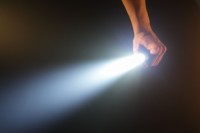I learned, in my recent move across the country, that I have an obsession with flashlights. I counted twelve flashlights total once I unpacked everything on the California side of the move. A few were still in their packaging, and some had expired batteries. That’s a flashlight for every room of the house, including the bathrooms, plus the garage and car.
 I barely have to turn a corner and there’s another flashlight in a drawer or a countertop, ready for that dark scary situation that may require some illumination.
I barely have to turn a corner and there’s another flashlight in a drawer or a countertop, ready for that dark scary situation that may require some illumination.
Not quite sure how I came about this fixation, other than my early days camping and as a Girl Scout. Or that time at age 13 when I got lost hiking with my friend Melinda on a trail we began in the afternoon and finally wandered back to the campsite long after dusk. Scared, cold, hungry. I must have sworn never to leave home without a light again.
Or maybe it has been the many scary things I’ve had to face as an adult that keeps me buying flashlights, as if they could ward off the negative events or mishaps that naturally occur in life. Like the pain, loss and suffering.
Yea, I bought another flashlight just before leaving Colorado. Not kidding.
I’d be lying if I said I hadn’t been scared silly about this huge move with its enormous transition, uprooting my teenager along with my own busy life. And occasionally panicked to be starting over in a place that was virtually unknown to me, and an equal distance from the last 27 years of my life as the distance across France.
Before I left, I’d find myself cogitating about “what if’s” that would cause me to have panic and anxiety. Some days the stress was overwhelming enough I’d need to meditate several times a day. It’s likely because the brain tends to react to and focus more on negative stimuli than positive, and painful experiences are usually more memorable than pleasurable ones (Baumeister et al, 2000, 2001).
You’ve probably had experiences like that. You know that things are likely to turn out OK, but a difficult experience of the past (being lost in the dark, stuck on the side of the road when your car breaks down, a job loss, a relationship ending) causes you to freak out at the thought of not having everything perfectly lined-up-planned-out-ready-for-misfortune.
But I haven’t used even one of those flashlights since I left, not even the little corkscrew-looking one that looks like an energy-efficient lightbulb on my keychain. It’s the thought of having them- like a security blanket- against the fear of unknown threats that are lurking.
And here’s the irony.
When you try so hard to protect yourself from unsafe or distressing situations- all that protecting, barricading, defending- it actually creates situations that are less safe.
 The stress of a panicked state triggers your nervous system to over-react and contract, which limits conscious and creative thought. And, you distance yourself from others who could help you because you’ve shut down your ventral vagal complex, your body’s mechanism for staying alert and engaging others.
The stress of a panicked state triggers your nervous system to over-react and contract, which limits conscious and creative thought. And, you distance yourself from others who could help you because you’ve shut down your ventral vagal complex, your body’s mechanism for staying alert and engaging others.
So much for the flashlights.
Dr. Peter Levine of the Somatic Experiencing® Trauma Institute teaches that your body has an innate capacity to heal itself and reduce the stress of traumatic experiences through a self-protective response. And when that response is allowed to “complete”- when you can “stay with” the experience and deactivate the trauma- then you can return to a non-stressful state without any harmful after-effects.
It’s when you run from your fear (like turning on a flashlight in every dark room), or dissociate altogether (avoiding the dark rooms, or the journey ahead, altogether), that the stress and trauma takes its toll.
This is one of the reasons mindfulness is so useful. In addition to creating a more calm state of awareness, it also allows you to embody the experience so that it can process the energy moving through your body during the stress, rather than allow it to get stuck and manifest as trauma later.
 As Riso & Hudson suggest, “if we are present to our experiences, the impressions of our activities will be fresh and alive, and we will always learn something new from them. But if we are not present, every moment will be like every other, and nothing of the preciousness of life will touch us” (Wisdom of the Enneagram).
As Riso & Hudson suggest, “if we are present to our experiences, the impressions of our activities will be fresh and alive, and we will always learn something new from them. But if we are not present, every moment will be like every other, and nothing of the preciousness of life will touch us” (Wisdom of the Enneagram).
So, uncomfortable as it was for me when my flashlights were useless, I listened to the signals of fear and panic in my body as I prepared to set-out on this journey. Ignoring the signals would have only worsened the effect, and I may never have arrived safely, nor have the optimism that now propels me forward.
And I didn’t get to this state of being able to “face my fears” overnight. It’s taken some time to learn to be with my discomfort, no matter how insignificant or severe the fear.
Learning to tolerate extreme discomfort, by being aware of and accepting what goes on in your body and accepting the sensations, will help you to temper those uncomfortable sensations and resulting feelings of fear and stress.
Unless you’ve experienced some significant childhood or adult trauma and have routine expression of stress as a felt sense in your body, you may not even be aware of how fear or stress manifests in your body.
Learning to tolerate stress or fear is primarily about being able to locate a sensation in your body, and experiencing it in a direct physical way, as opposed to a cognitive thought or an emotion, which are both interpretations of the sensation.
Next time you feel stress or fear, or discomfort of any sort, ask yourself where exactly in your body do you feel it, and exactly what is the physical sensation? Is it tightness? A constriction? A fluttery feeling? Heart palpitating? What is your breathing like? Are there butterflies in your stomach, or a big knot?
 Just notice the sensations. Shine a light on them, pay attention, and likely they will lessen or go away altogether.
Just notice the sensations. Shine a light on them, pay attention, and likely they will lessen or go away altogether.
Who said flashlights can only be used when camping.
If you’re having trouble facing the fears, stress or burdens in your life, contact me for a Free 30-minute Strategy Session to see how you can move forward. Or download the free e-Book Calm Your Body & Mind, Reduce Your Stress: 10 Easy Ways to Counteract Life’s Rollercoaster and find simple ideas to reduce the stress or fears in your life.
Holly Woods, Ph.D. helps adults who want to overcome their stress and anxiety and who want to learn a different way to live and work. I work with people in-person, by skype or phone. I use Integral Coaching, Somatic Experiencing, non-violent communication, mindfulness, energetic healing, consciousness expansion methods and other modalities to help you overcome stress and anxiety so you can live your best life. Contact me for a Free Strategy Session.
